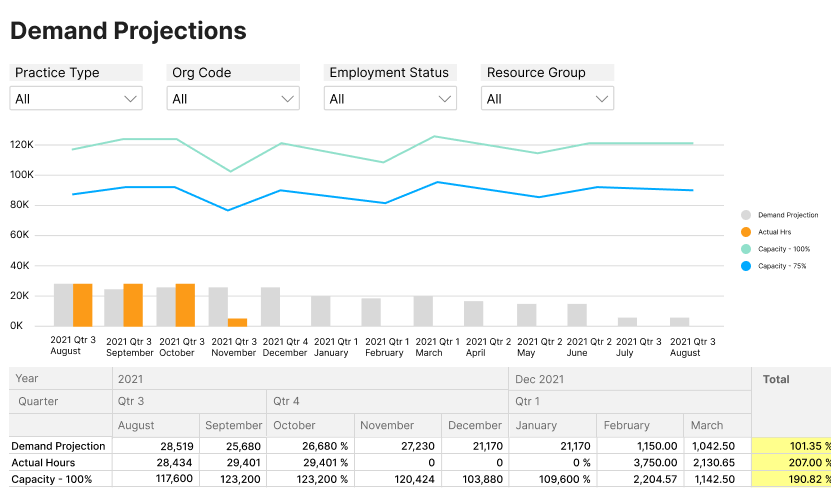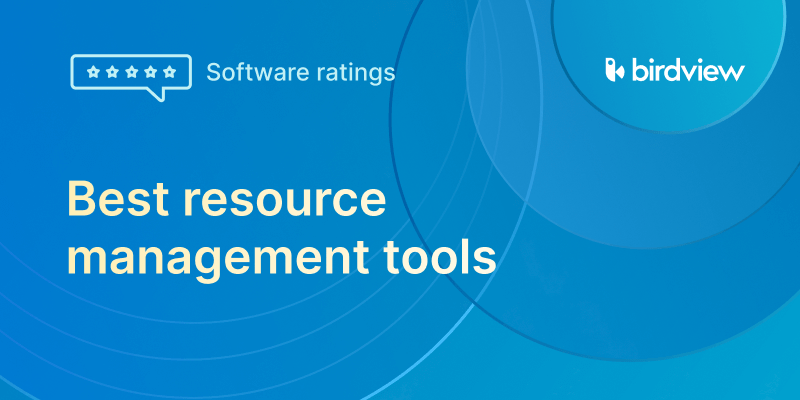If you‘re in the professional services industry, you know how crucial it is to have the right resources available and used efficiently to complete projects successfully. Two vital components of resource management in professional services are capacity planning and resource scheduling. Though often confused, they play distinct roles. This article dives into the differences between the two, highlighting their significance and how they work together to ensure project success. Discover how capacity planning secures future resource availability, while resource scheduling fine-tunes the allocation and timing for optimal performance right now.
What is capacity planning?
“Volatile and non-stationary demand, very complex production processes, long production and capacity acquisition lead times, and extremely high and rarely reversible capacity acquisition costs make capacity planning in the high-tech industry a particularly challenging managerial task.” European Journal of Operational Research
Capacity planning is a strategic process where you determine the production and human capacity your organization needs to meet changing demands. It‘s all about making sure you have the right resources at the right time, so you don‘t overstretch or underutilize them.
The goal is to ensure that skilled resources are available to meet growing customer and business needs. This involves preparing for any changes that might come up during a project, so your team can adapt and respond effectively. This proactive approach keeps projects running smoothly and aligns resources with evolving requirements.
Key elements of capacity planning
- Forecasting: Predicting future demand based on historical data, market trends, and business growth projections.
- Resource assessment: Evaluating current resource availability, including personnel, equipment, and facilities.
- Balancing supply and demand: Ensuring that the organization can meet future demands without overstretching resources.
- Scalability: Planning for future growth by ensuring that resources can be scaled up or down as needed.
Read more:
Resource planning and capacity planning reporting and dashboards
Resource management metrics and KPIs in project management
Resource management in project management: process, tools
How to apply capacity planning in your professional services business
Types of capacity planning strategies.
Capacity planning is essential for ensuring that an organization can meet future demands without overloading or underutilizing resources. There are several capacity planning strategies, each tailored to different business needs and scenarios. Here are the main types of capacity planning strategies:
1. Lead strategy
A lead strategy involves adding capacity in anticipation of future demand. This proactive approach aims to meet expected increases in demand, preventing potential shortages and capitalizing on market opportunities.
Example: A Consulting Firm hires additional analysts before launching a major marketing campaign. This ensures they can handle the expected influx of new clients and projects, preventing delays and maintaining high service quality.
2. Lag strategy
The lag strategy focuses on adding capacity only when there is a clear increase in demand. This reactive approach minimizes the risk of over-investment and reduces idle capacity.
Example: An IT Consulting Firm waits until project requests consistently exceed current staffing levels. They then hire additional technicians to handle the increased workload, ensuring resources are used effectively and only when necessary.
3. Match strategy
The match strategy, or tracking strategy, seeks to balance the timing of capacity additions with demand fluctuations. It involves incremental adjustments to capacity, adding resources as demand increases, and scaling back when demand decreases.
Example: An Accounting Firm gradually increases its team of accountants and auditors during tax season. As demand peaks, they add more staff, and once the busy period is over, they scale back to maintain efficiency without overstaffing.
4. Adjustment strategy
An adjustment strategy involves fine-tuning capacity in response to real-time changes in demand. This flexible approach is often used in dynamic environments where demand can be unpredictable.
Example: A Marketing Agency hires freelance designers when a sudden, large client project comes in. This allows them to quickly adjust their capacity to meet project needs without the long-term commitment of hiring full-time staff.
5. Dynamic strategy
The dynamic strategy combines elements of the other strategies to create a more responsive and adaptable approach. It involves continuous monitoring of demand and capacity, using data analytics to make real-time adjustments.
Example: A Management Consultancy uses data analytics to continuously monitor project pipelines and resource utilization. This allows them to dynamically allocate consultants to high-priority projects, balancing long-term planning with immediate needs and ensuring optimal resource use.
Choosing the right capacity planning strategy helps firms optimize resource use, meet client demands efficiently, and maintain successful project outcomes. Being proactive and adaptable ensures resources align with business goals and project requirements.
Choosing the right capacity planning strategies
The choice of capacity planning strategy depends on several factors, including the nature of the business, market conditions, and the level of demand variability. Here are some considerations:
- Market Predictability: Businesses in stable markets may benefit from a lead strategy, while those in volatile markets might prefer a lag or adjustment strategy.
- Resource Flexibility: Companies with flexible resources (e.g., temporary staff, and scalable cloud services) can adopt dynamic or adjustment strategies.
- Risk Tolerance: Organizations with a higher tolerance for risk might invest in a lead strategy, while those seeking to minimize risk might favor a lag strategy.
- Growth Objectives: Firms aiming for rapid growth may adopt proactive strategies like lead or match, ensuring they are prepared to meet future demands.
By understanding and selecting the appropriate capacity planning strategy, organizations can better align their resources with demand, optimize operations, and achieve their strategic goals.
Steps of the Capacity Planning Process
Capacity planning is vital for making sure an organization can handle future demands without straining or wasting resources. Imagine it as a proactive approach to keep everything running smoothly and efficiently.
Here’s how you can master this process:
1. Assess current capacity. Begin by evaluating the current capacity of your resources. This involves understanding the current workload, resource utilization, and performance levels.
2. Forecast future demand. Predict future demand based on historical data, market trends, and business growth projections. Accurate forecasting helps in anticipating the resources required to meet future needs.
3. Identify capacity gaps. Compare the current capacity with the forecasted demand to identify any gaps. Determine whether the existing resources are sufficient to meet future demands or if there will be shortages or surpluses.
4. Develop a capacity plan. Create a detailed capacity plan that outlines how to address the identified capacity gaps. This plan should include strategies for scaling up or down, such as hiring additional staff, purchasing new equipment, or optimizing current resources.
5. Implement the plan. Execute the capacity plan by taking the necessary actions to adjust capacity. This might involve recruiting new employees, acquiring new technology, or reconfiguring existing resources.
6. Monitor and review. Continuously monitor the effectiveness of the capacity plan and make adjustments as needed. Regularly review capacity utilization, resource performance, and demand forecasts to ensure the plan remains aligned with business needs.
7. Refine and optimize. Based on the monitoring and review phase, refine and optimize the capacity plan to improve efficiency and responsiveness. Implement changes to address any issues or opportunities for improvement.
Example: Assessing the demand. An engineering firm analyzes historical data to gauge service demand. They consider current projects, upcoming proposals, seasonal trends, and client needs. This comprehensive analysis allows them to project future demand accurately and plan staffing needs accordingly. By understanding these factors, the firm can ensure that engineers with the right skills are available when needed, optimizing resource management and preparing for fluctuating workloads.

What is resource planning?
Resource planning, on the other hand, is all about getting into the nitty-gritty details of who does what and when. It’s like piecing together a puzzle where you identify the resources needed for each task, assign the right people, and keep a close eye on their progress. This ensures that every task is completed efficiently and that the project stays on track. Think of it as the tactical game plan that makes sure all the moving parts work together seamlessly to achieve the project‘s goals.
Key elements of resource planning
- Resource allocation: Assigning the right resources to the right tasks based on their skills, availability, and the project’s requirements.
- Scheduling: Creating detailed timelines that outline when and how resources will be used throughout the project lifecycle.
- Monitoring utilization: Continuously track resource usage to ensure they are utilized effectively and adjust as needed.
- Conflict resolution: Addressing and resolving any conflicts that arise due to resource constraints or scheduling overlaps.
Read more:
What is Resource Utilization and Analysis?
Example of resource planning
An IT service provider is tasked with implementing a new software system for a client. Resource planning involves assigning experienced software engineers to critical development tasks while junior engineers handle testing and support roles. They create a detailed schedule to ensure all team members know their responsibilities and deadlines. Throughout the project, they monitor the engineers’ workloads to avoid burnout and ensure that resources are used efficiently.

Differences between capacity planning and resource planning
Although both capacity planning and resource planning are essential for effective project management, they serve different functions and operate at distinct levels within an organization.
Capacity planning is the strategic big-picture approach, ensuring that resources are available for future demands. In contrast, resource planning dives into the details, focusing on the tactical allocation and scheduling of resources to optimize their use in current projects. Together, they create a comprehensive strategy for managing resources efficiently.
Scope and focus
- Capacity planning: Broad and strategic, focusing on the overall ability of the organization to meet future demands. It looks at the big picture, including long-term goals and scalability.
- Resource planning: Detailed and tactical, concentrating on the specific allocation and scheduling of resources for current projects. It deals with the day-to-day management of tasks and resources.
Time horizon
- Capacity planning: Long-term, often looking months or years into the future to anticipate resource needs based on projected demand.
- Resource planning: Short-term, typically focusing on the immediate needs of current projects and tasks.
Objectives
- Capacity planning: Ensures that the organization can scale and adapt to future changes in demand without experiencing resource shortages or surpluses.
- Resource planning: Optimizes the use of available resources to complete tasks and projects efficiently, ensuring that deadlines and quality standards are met.
Methods and tools
- Capacity planning: Uses forecasting models, scenario analysis, and strategic planning tools to predict future resource needs and plan accordingly.
- Resource planning: Utilizes project management software, Gantt charts, and resource allocation matrices to assign and monitor resources for specific tasks.

Combining capacity planning and resource planning
In the world of project management, it’s not enough to just look at the big picture or focus on the details–you need to do both. Combining capacity planning and resource planning allows organizations to seamlessly integrate strategic foresight with tactical precision. This holistic approach ensures that resources are not only available when needed but also used efficiently on the ground. By merging these two essential processes, you can create a robust framework that supports both long-term objectives and day-to-day project execution, driving success across all levels of your organization.
Here‘s how they can complement each other:
Aligning long-term and short-term goals
Capacity planning provides the strategic framework within which resource planning operates. By understanding long-term resource needs, organizations can ensure that they have the necessary resources available for short-term projects.
Example: An IT services company might use capacity planning to forecast the need for additional software developers based on projected client demand. Resource planning then allocates these developers to specific client projects, ensuring that both current and future needs are met.
Real-time adjustments
Resource planning provides real-time data on resource usage, which can inform capacity planning decisions. If a project is experiencing resource constraints, capacity planning can be adjusted to address these issues.
Example: If a marketing agency finds that its graphic designers are consistently overbooked, resource planning data can highlight this issue, prompting capacity planning to hire more designers or outsource some tasks.
Scenario analysis
Capacity planning can use insights from resource planning to conduct scenario analysis and plan for different contingencies. This ensures that the organization is prepared for various possible future scenarios.
Example: A manufacturing firm might use resource planning data to analyze the impact of a sudden increase in demand. Capacity planning can then develop strategies to scale up production, such as adding new production lines or hiring temporary workers.
Tools and techniques for effective capacity and resource planning
Capacity planning tools
- Forecasting software: Tools like Salesforce Analytics, Oracle Demand Planning, and Birdview PSA help predict future resource needs.
- Scenario analysis tools: Software like Whatif or Crystal Ball and Birdview PSA can simulate different demand scenarios and their impact on resources.
- Strategic planning tools: Platforms like SAP or Birdview PSA with integrated resource planning offer comprehensive solutions for long-term capacity planning.
Resource planning tools
- Project Management Software: Tools like Birdview PSA, Microsoft Project, or Asana provide functionalities for resource allocation, scheduling, and tracking.
- Gantt Charts: Visual tools that help plan and track project timelines and resource usage. Tools like Birdview PSA have interactive Gantt charts to plan and visualize your work the smart way.
- Resource Allocation Matrices: Help visualize the distribution of resources across tasks and identify potential conflicts or bottlenecks.
Capacity planning and resource planning are distinct but complementary processes crucial for effective project management.
By integrating these two processes, organizations can achieve optimal resource utilization, better project outcomes, and increased overall efficiency.
Capacity planning and resource planning in Birdview PSA
Birdview PSA excels in capacity and resource planning by forecasting future needs and optimizing current resource allocation. Capacity planning ensures that the right resources are available when needed, preventing shortages and overuse.
Resource planning focuses on assigning and scheduling resources for specific tasks, tracking utilization in real time, and making necessary adjustments.
Together, these features help organizations manage workloads efficiently and achieve project goals effectively.
Read more:
Resource management in project management: process, tools, benefits & technique
Resource scheduling in project management: an essential guide
Smart resource allocation and task scheduling: How do you do this



